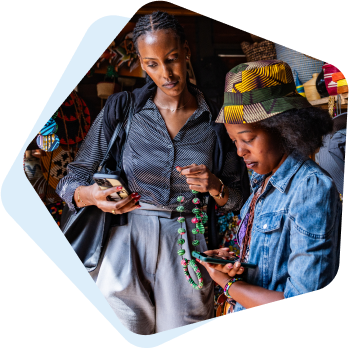How to Implement
Guidance

Support common Scheme branding.
Scheme adoption of a common brand name and identity that is used by all DFSPs promotes the Inclusive IPS and encourages usage. When end users recognize the common brand at merchants or other access points, they know the service is useful to their daily lives.

Ensure overall quality through brand guidelines.
The Inclusive IPS should provide guidelines to DFSPs on how to properly display the brand name and logo to ensure consistent usage and presentation.

Collect end user input on brand.
The Inclusive IPS develops the common trade name and logo with input from end users, with particular attention to women end users, to ensure it is relevant, recognizable, and builds trust.
Why It Matters
This makes digital payments more recognizable, trusted, accessible, widely adopted, and ultimately, more useful. This creates a level of equity in branding among DFSPs.
Seeing More Clearly
Select a lens to learn the “why” this practice.
Women’s Inclusion
Data suggests that all users’ adoption of digital payments is boosted by a common, recognizable brand. For many women users less familiar with and trusting of digital payments generally, a common brand builds trusts – encouraging use and ultimately driving down costs, thus overcoming common barriers to women’s inclusion.

Tools
Design Guides
Dig into how to implement each of the practices.
Minimum Branding Guidelines
Overview of select features that constitute minimum branding guidelines, namely in-app logo placement, logo repetition, and point-of-sale experience requirements.
Review Minimum Branding GuidelinesAim for Common, Consumer-Facing Brand
Overview of potential brand design choices for Inclusive IPSs, alongside implications and representative examples from the market.
Review Aim for Common, Consumer-Facing BrandAlternative Opportunities for Schemes to Solicit Feedback
Description of less formal alternatives to consumer forums that Inclusive IPSs can use to solicit feedback from women end-users.
Review Alternative Opportunities for Schemes to Solicit FeedbackCriteria for Selecting Women-Centered Consumer Groups to Inform Inclusive IPS Design and Feedback
Description of mechanisms for ensuring that consumer group engagement in the Inclusive IPS design process is representative of the diversity of women end users.
Review Criteria for Selecting Women-Centered Consumer Groups to Inform Inclusive IPS Design and FeedbackWho to Invite to a Consumer Forum
List of potential participants in an Inclusive IPS consumer forum.
Review Who to Invite to a Consumer ForumGovernance Structure for Inclusive IPS Consumer Forum
Overview of a potential governance structure for an Inclusive IPS consumer forum.
Review Governance Structure for Inclusive IPS Consumer ForumConsumer Forums Provide a Formal Mechanism to Embed Voices of End-Users
Description of benefits of consumer forums in ensuring that women’s voices are included in ongoing design feedback, alongside examples of such forums in the market.
Review Consumer Forums Provide a Formal Mechanism to Embed Voices of End-UsersApproaches to Ensuring Representative and Diverse Leadership in the Inclusive IPS Ecosystem
Overview of strategies Inclusive IPSs can deploy to increase the share of women in leadership.
Review Approaches to Ensuring Representative and Diverse Leadership in the Inclusive IPS EcosystemGeneric payments scheme rulebook categories and example table of contents
A generic scheme rules that IIPS operators can use to build their own rulebook
Review Generic payments scheme rulebook categories and example table of contentsPractitioner’s Guide to Payments Scheme Governance and Financial Inclusion
A practical guide to payment scheme governance, outlining key considerations, structure types, and best practices to ensure financial inclusion within digital financial systems, with actionable…
Review Practitioner’s Guide to Payments Scheme Governance and Financial InclusionMarket Illustrations
Learn from design choices in action.
Bre-B (Colombia) Standardizes Brand and Experience to Improve Trust in the Central Bank Brand
Country
Colombia
Challenge
Banco de la República wished to establish brand guidelines on where and how to use the Bre-B logo to ensure its prominence and clear visibility to users.
Outcome
These strong guidelines, which highlight the overlap between brand and user interface, and enablement of the brand by the Central Bank help define an ecosystem of dependability and trust.
UPI’s Common Brand Ensures Consistency and Builds Trust
Country
India
Challenge
The National Payments Corporation of India (NPCI) wished to establish a clear and consistent brand across UPI and the associated BHIM payment service as the operator of UPI in order to increase trust in and adoption of UPI.
Outcome
The UPI brand is widely recognized and adoption of UPI enabled payments is high and continues to grow.
Banco Central do Brasil Offers Guidance, and Flexibility, in Deploying the Pix Brand
Country
Brazil
Challenge
Banco Central do Brasil committed to improving the visibility of the Pix brand across a diverse ecosystem of digital providers and digital and physical merchants while ensuring consistency.
Outcome
Pix’s brand is well-recognized in Brazil and associated with a trustworthy, innovative payments ecosystem.
Brazil’s Pix Forum – A Multi-Stakeholder Convening to Inform Design
Country
Brazil
Challenge
In preparation for the launch of Pix in November 2020, the Banco Central do Brasil (BCB) faced the complexity of designing an instant payment infrastructure that could serve a wide range of users—including individuals, businesses, and government entities.
Outcome
Members of the Forum have lauded its usefulness, and the Forum remains active today, continuing to inform Pix design.
Bank of Etihad’s Holistic Approach to Increase Women’s Representation in Jordan
Country
Jordan
Challenge
Jordan had a low female labor force participation rate of just 14%, which affected both staffing at financial institutions and depressed demand for financial services themselves.
Outcome
The bank’s initiatives yielded significant outcomes since its launch in 2014, with positive impacts across its board, workforce, and client base.
Bank of Tanzania Circular Promotes Women’s Participation on Boards
Country
Tanzania
Challenge
Despite progress in expanding financial inclusion in Tanzania, gender disparities remained pronounced in the leadership structures of banks and financial institutions. This imbalance posed both an ethical and economic challenge.
Outcome
This directive positions Tanzania as a regional leader in embedding gender equity into financial sector governance through concrete targets, timelines, and regulatory oversight. Initial results suggest promising trends in adoption.
Nigeria Promotes Women’s Leadership in the Banking Sector
Country
Nigeria
Challenge
In 2012, the Central Bank of Nigeria (CBN) recognized a persistent gender imbalance in the leadership of the banking sector.
Outcome
As a direct result of a 2012 circular promoting a culture to support women’s leaders and concrete targets for women’s leadership in the financial sector, the Nigeria banking ecosystem successfully implemented all but one of the direct and environmental methods to increase the overall pipeline and percentage of women in Board and Leadership positions of Banks.
Related Resources
Explore more practices
Review other L1P practices and learn more about how to apply them to your IPS.

